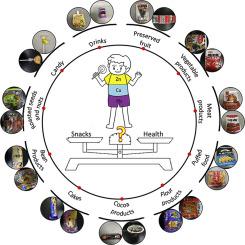Chemosphere ( IF 8.1 ) Pub Date : 2020-07-07 , DOI: 10.1016/j.chemosphere.2020.127547 Yu Gao 1 , Xiaoping Li 1 , Jie Dong 1 , Yuhan Cao 1 , Tao Li 1 , Howard W Mielke 2

|
Snack foods are common and highly advertised to children and serve their natural predispositions for sweet and salty tastes. However, the risk issues of low-cost snacks eaten by 0–6 aged children are lack of more concern. To better understand the issue of low-cost snacks this study considered potentially toxic metals (PTMs) impact on children’s health risk, measured PTMs in a collection of 570 collected low-cost snacks contributed by 1342 voluntary participants children aged 0–6 years involved in Xi’an city are conducted. Nine priority PTMs and amounts ranked as Mn > Zn > Cu > Cr > Sb > Pb > Ni > Cd > Co. The Estimated Weekly Intake of PTMs in snacks for children accounted for a proportion of the Provisional Tolerance Weekly Intake. Children’s daily snack ingestion of Cr, Cd and Pb were especially concerning. It was noted that all PTMs in flour products contribute to the total Target Hazard Quotient (THQ>1) were observed having a non-carcinogenic risk compared to the single metals Cr, Co and Cd with carcinogenic risk. The correlations between Cu, Pb, Zn in low-cost snacks and children’s bloods reflected PTMs especially for Pb that transfers into children’s bodies mostly through low-cost foodstuffs ingestion. Also, the elevated blood lead levels (BLLs) depended on readily available, low-quality snacks accessible for children. Therefore, multi-initiatives aimed at improving the quality, increasing awareness, and a PTM monitoring program for low-cost snack food market to young children should be undertaken.
中文翻译:

零食和学龄儿童的铅摄入风险:对潜在有毒金属和儿童对血铅,铜和锌水平的暴露反应的比较评估。
零食很普遍,对儿童也很受广告欢迎,它们具有甜味和咸味的天然诱因。然而,0至6岁的儿童食用低成本零食的风险问题并未引起更多关注。为了更好地理解低成本零食的问题,本研究考虑了潜在的有毒金属(PTM)对儿童健康风险的影响,对1 342名0-6岁的自愿参与者儿童参与的570种收集的低成本零食的集合中的PTM进行了测量西安市进行。九种优先PTM的数量依次为Mn> Zn> Cu> Cr> Sb> Pb> Ni> Cd>Co。儿童零食中PTM的估计每周摄入量占临时耐受性每周摄入量的一部分。儿童每日零食摄入铬,镉和铅尤为重要。值得注意的是,与具有致癌风险的单一金属Cr,Co和Cd相比,发现面粉产品中的所有PTM均对总目标危险商(THQ> 1)产生了非致癌风险。低成本零食中的Cu,Pb,Zn与儿童血液之间的相关性反映了PTM,尤其是对于Pb,Pb主要通过廉价食物的摄入而转移到儿童体内。此外,血铅水平升高(BLL)取决于儿童容易获得的低质量零食。因此,应该采取旨在提高质量,提高认识的多种举措,并针对低价休闲食品市场向幼儿提供PTM监测计划。1)与具有致癌风险的单一金属Cr,Co和Cd相比,具有非致癌风险。低成本零食中的Cu,Pb,Zn与儿童血液之间的相关性反映了PTM,尤其是对于Pb,Pb主要通过廉价食物的摄入而转移到儿童体内。此外,血铅水平升高(BLL)取决于儿童容易获得的低质量零食。因此,应该采取旨在提高质量,提高认识的多种举措,并针对低价休闲食品市场向幼儿提供PTM监测计划。1)与具有致癌风险的单一金属Cr,Co和Cd相比,具有非致癌风险。低成本零食中的Cu,Pb,Zn与儿童血液之间的相关性反映了PTM,尤其是对于Pb,Pb主要通过廉价食物的摄入而转移到儿童体内。此外,血铅水平升高(BLL)取决于儿童容易获得的低质量零食。因此,应该采取旨在提高质量,提高认识的多种举措,并针对低价休闲食品市场向幼儿提供PTM监测计划。此外,血铅水平升高(BLL)取决于儿童容易获得的低质量零食。因此,应该采取旨在提高质量,提高认识的多种举措,并针对低价休闲食品市场向幼儿提供PTM监测计划。此外,血铅水平升高(BLL)取决于儿童容易获得的低质量零食。因此,应该采取旨在提高质量,提高认识的多种举措,并针对低价休闲食品市场向幼儿提供PTM监测计划。











































 京公网安备 11010802027423号
京公网安备 11010802027423号